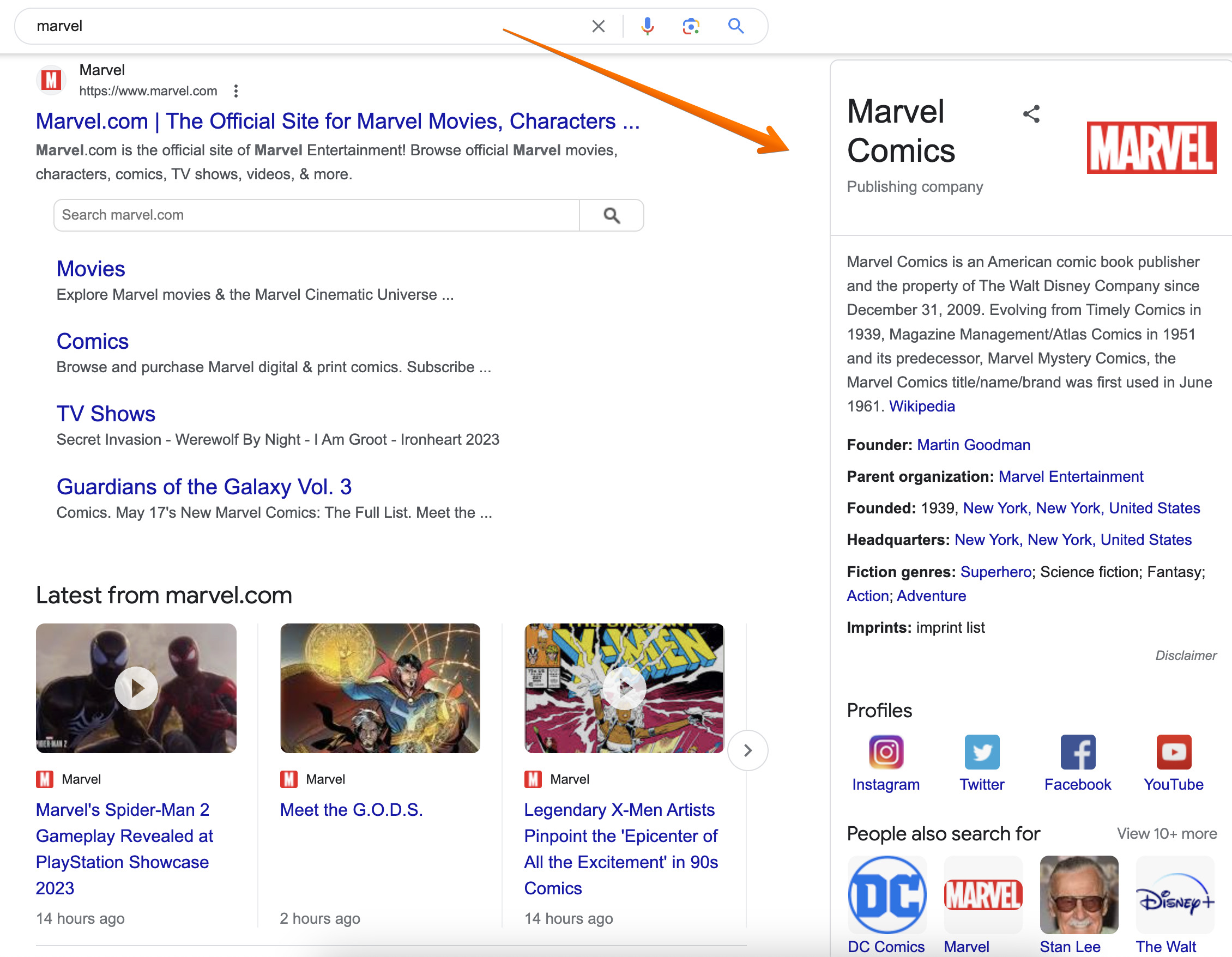Google Knowledge Graph
What is the Google Knowledge Graph?
Google’s Knowledge Graph is a database of facts about people, places, and things (known as entities) and the relationships between them. Google uses the Knowledge Graph to show the Knowledge Panels on SERPs - the snapshots of information on an entity.
An entity is any object or concept that can be distinctly identified, such as people, places, and things – think “things, not strings.” Google uses a range of sources to power the Knowledge Graph, but the most important include Freebase, Wikipedia, and the CIA World Factbook.
Here’s an example of the Knowledge Graph in action:

Why is the Knowledge Graph important?
The Knowledge Graph is very important for Google because it improves the user experience by providing key information right on SERP. People don’t need to click on the search results and search for the answer on the web pages. This is especially useful for voice search and virtual assistants.
It also helps Google differentiate queries that are spelled the same but have different meanings.
While the Knowledge Graph is good for Google, it may be bad for the websites that are not getting clicks from the questions immediately answered by Google. Nearly 50% of searches now result in no clicks, which is partly due to the convenience of answered queries from the Knowledge Graph appearing right in the SERP.
How to become an entity in the Knowledge Graph?
One way to take advantage of the Knowledge Graph for your brand is by becoming an entity in the Knowledge Graph.
An entity in the Knowledge Graph is always something popular. So, if nobody is speaking about you or your brand online, there’s no chance Google will recognize you as an entity. But there are a few tips that can hep you become an entity faster and get your own knowledge page:
1. Get profiles on all major social networks
Establish profiles on all of the major social networks, including Facebook, YouTube, Twitter, Instagram, and LinkedIn. Fill in all possible details, especially the business description and business address.
Then, put a priority on attracting followers to boost the visibility of your entity to Google’s Knowledge Graph.
2. Use schema markup on your site
Google heavily relies on schema data to understand the content and describe things better. Don’t miss the opportunity to make your entity more attractive to Google’s Knowledge Graph by implementing schema and using the relevant type of structured data.
There are quite a few: organization, author, person, place, restaurant, etc.
3. Get a Google My Business profile
If your business has a physical location, you should claim a Google My Business profile. Admittedly, it’s not always possible, but it’s a must if you can – Google uses it as one of the sources for the Knowledge Graph.
Even if you do sign up for a Google My Business profile, it doesn’t guarantee that your business will be included in the Knowledge Graph. However, this is another factor that can improve your chances.
4. Create a wikidata.org entry
Wikidata is a free and open knowledge graph hosted by the Wikimedia Foundation. Similar to Wikipedia, this knowledge graph is collaboratively edited by virtually anyone – and the resulting knowledge base can be read and edited by both humans and machines under a free license.
Because it’s a common source of open data, Wikidata is often relied upon for Wikipedia entries and for Google’s Knowledge Graph. If you have a business or other entity you want in the Knowledge Graph, be sure to create your own entry on Wikidata. Just make sure you do your best to comply with the Notability policy.
5. Try to get a Wikipedia page
Similar to the Google My Business profile, getting a Wikipedia page isn’t always possible, but it’s advisable if you can. Wikipedia is a valuable source of data for Google’s Knowledge Graph to provide rich results in the SERPs.
You can try to create your own Wikipedia page, but it’s a doomed effort unless you adhere to Wikipedia’s strict policies and guidelines.
Often, the best way to get a Wikipedia page is to grow your business brand to the point where it’s getting mentions from authoritative third-party sources. Then, someone who isn’t affiliated with your business will feel compelled to create a Wikipedia page about your business instead.
5. Grow your brand
This may sound obvious, but becoming more popular in general is the most direct way to become an entity, and consequently get into Knowledge Graph and receive your own Knowledge Panel.
When it comes to growing your brand, this can include activities like building your website’s backlink profile, growing organic search traffic from Google, advertising with paid media, getting more views on YouTube, increasing your social media following, and attracting more brand mentions on the web through PR efforts.
Brand growth can also be influenced by offline activities like business development, attending conferences and trade shows, sponsorships, and networking.
FAQs
What is the Google Knowledge Panel?
The Google Knowledge Panel is a rich result that appears on the right-hand side of Google’s SERPs (on desktop) when someone searches a query related to the topic. The Knowledge Panel is a special box with useful data sourced by Google’s Knowledge Graph.
Note that while individuals and organizations can provide feedback and verify information in their panels, they aren’t allowed to control or change a panel. Google has the final say on the contents of any given Knowledge Panel.
What is an entity?
An entity is any object or concept that can be distinctly identified, such as people, places, and things. Each entity is connected to other entities by nodes in Google’s Knowledge Graph, and all of this data is routed into knowledge panels or cards that appear in the SERPs.
Google relies on a handful of authoritative sources to provide data for its Knowledge Graph, including Freebase, Wikipedia, and the CIA World Factbook.